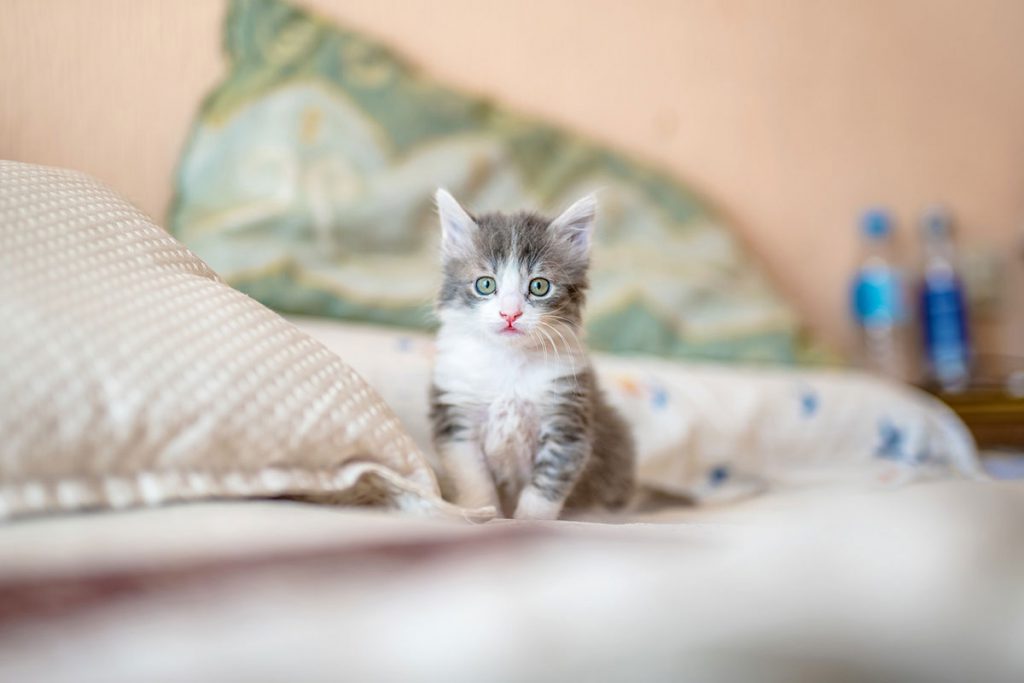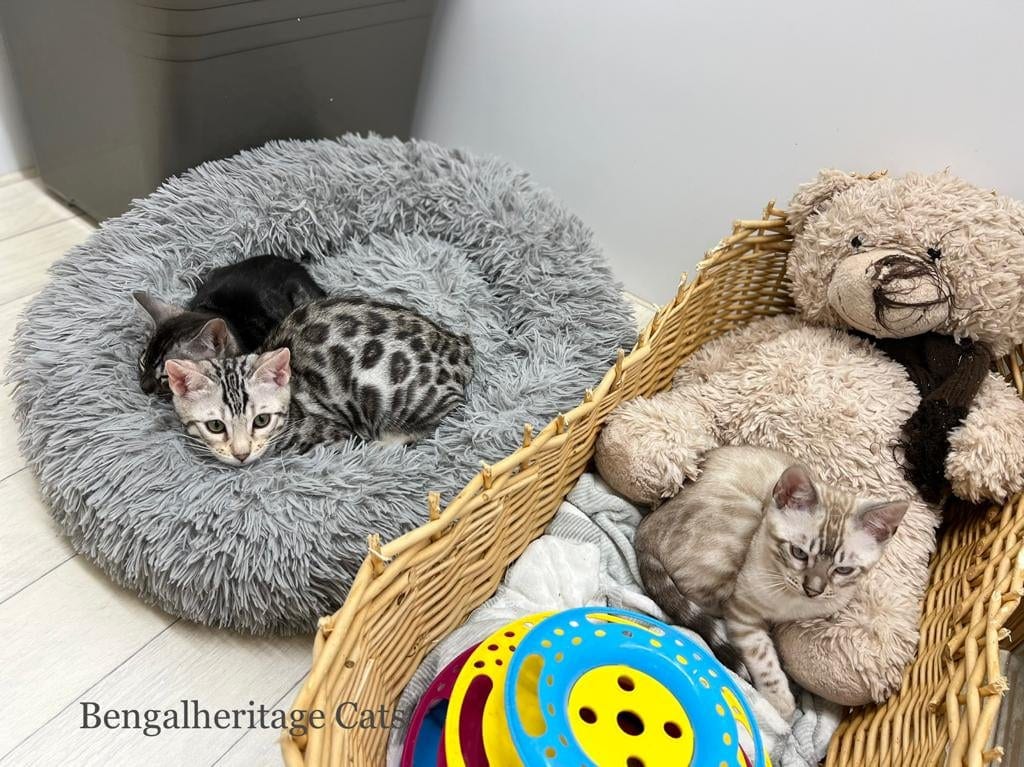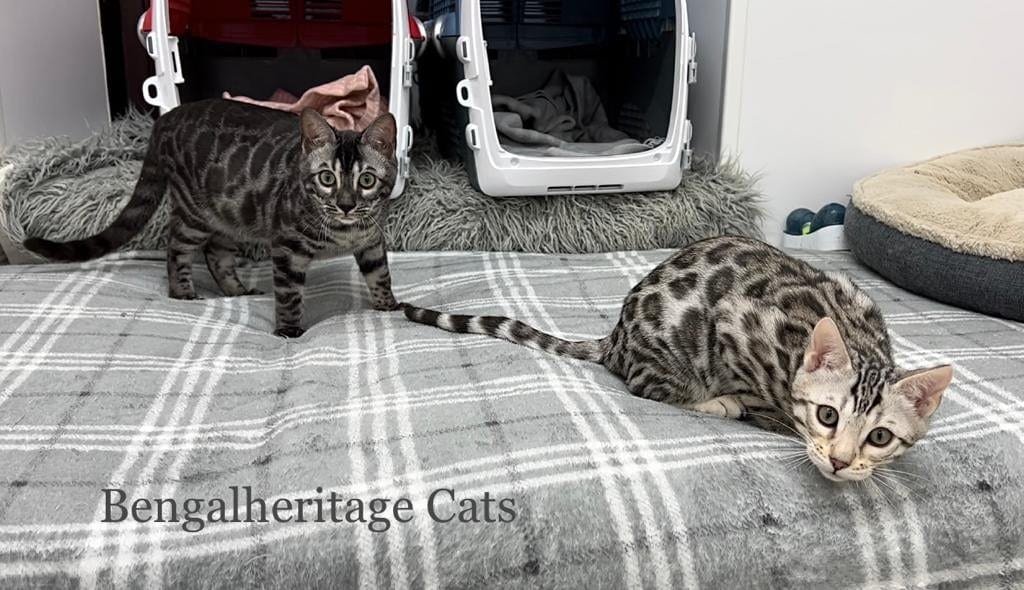
All cats, including those that live predominantly outdoors, need a safe and clean environment and protection from hazards. Some examples of hazards include household
chemicals, poisonous plants and open windows or balconies in high buildings, which your cat might try to get out of. All cats need a safe, comfortable place to rest undisturbed. Cats that live outdoors, need access to a safe shelter and a source of food and water. Living in a cold or wet place, without shelter, can cause a cat to suffer. A cat must be able to avoid things that scare them, including other cats and they all need a place to hide where they feel safe. They often feel safest when high up. If unable to hide and avoid threats, your cat may suffer anxiety and chronic distress, which can lead to illness.
Cats naturally enjoy exploring their environment. They are athletic animals and need opportunities to run, jump and climb and if they do not they may suffer. Cats are naturally clean animals and need regular, easy access to an appropriate place to go to the toilet. They do not like to use heavily soiled areas. Some cats need to use an indoor toilet area, for example a litter tray. Cats are territorial and become very attached to their own familiar environment. They are naturally cautious in unfamiliar environments, including around new places, smells, other animals and people. For example, if you have to travel with your cat to a
What you should do:
• Provide your cat with a safe, comfortable, dry, draught-free, clean and quiet place where it can rest undisturbed. Ideally, there should be
a range of such places available – the cat will choose where it is most comfortable.
• Take all reasonable steps to protect your cat from hazards indoors and outdoors.
• Make sure your cat has constant access to a variety of safe hiding places including elevated resting places,where it can feel safe.
• If your cat does not go outside, make sure it has plenty of activities to do and enough space to exercise, climb and play indoors.
• Your cat should be provided with a suitable toilet area, that is quiet, easily accessible and kept clean.
• Before you move your cat, you should gradually get it used to a secure cat carrier. Putting items which smell like the cat, for instance its blanket, in the carrier and any place you move your cat to can help it feel at ease.
• Any place where your cat is left must be large enough and comfortable with effective ventilation and temperature control so that your cat is able to move around to ensure its comfort, avoiding becoming too hot or too cold. Never leave your cat in an area where this is not possible such as a car ona warm day.
• Your cat should not be routinely kept in a cage.
• If you have any concerns about moving to a new home, or transporting your cat, you should consult a vet or other suitably qualified cat care specialist.

Understanding the Animal Welfare Act 2006
Introduction to the Code
Owning and caring for a cat can be a source of great enjoyment, but you should be aware that cat ownership is a major responsibility. Typically, cats live for about 14 years, but some
live much longer than this. Consequently, you should think carefully about all factors that will affect your ability to care for a cat and whether a cat is suitable for you. Would you be able to provide for all of a cat’s needs? You will need to consider the size and location of your property, and the financial and time implications of having a cat as a pet.Caring for a cat can be expensive and you should consider whether, for instance, you would be able to afford the cost of routine and unexpected veterinary treatment, or the cost of pet health insurance. There is no one “perfect” way to care for all cats because every cat, and every situation, is different but they all have the same needs. It is up to you to find out what your cat’s precise needs are and how to meet them. Under Section 9 of the Animal Welfare Act 2006 (the Act)
you must take such steps as are reasonable in all circumstances to ensure that the needs of an animal for which you are responsible are met, to the extent required by good practice
which are set out in the Act as follows:
Under the Act you are always responsible for your cat’s needs.Furthermore, if you are a parent or guardian of a child under the age of 16 years old,you are responsible for any animal that child is in charge of. If you are unable to care foryour cat at any time, you must make arrangements for another suitable person to look after them on your behalf. It is important to remember that you remain responsible for your
cat’sneeds, even when you are away. The person with whom you leave your cat will also belegally responsible for your cat’s welfare in your absence.If you own, or are responsible for, a cat and fail to meet their welfare needs or cause themunnecessary suffering, you may be prosecuted under the Act.

Cats need fresh clean drinking water at all times. Without water to drink a cat will become distressed and seriously ill.
Cats need a well-balanced diet to stay fit and healthy, and they all need foodstuffs that can only be derived from meat-based products. Individual dietary needs depend
on many factors including age, activity and state of health. Some cats have special dietary needs – for example, pregnant and nursing cats, young growing cats, old cats and cats that are ill. Cats generally prefer to eat several small meals each day. How much food a cat needs depends on their age, the type of
food, bodyweight and level of activity.If a cat eats more food than they need, they will become overweight, suffer and this could cause health problems and suffering. If you underfeed your cat, they will lose weight and may become ill. Healthy adult cats should maintain a stable body weight that is neither too thin nor too fat. Your vet can advise on the
correct weight for your cat. Many cats will not eat if their food is placed too close to their toilet site or something they are frightened of.
What you should do:
• Provide your cat with fresh clean drinking water at all times, preferably located away from their food source.
• Make sure your cat eats a balanced diet suitable for their individual needs.
• If you are uncertain of the diet your cat needs, take advice from your vet or other suitably qualified cat care specialist.
• Read, and be guided by, the feeding instructions relating to any cat foods you buy. Adjust how much you feed your cat to make sure they do not becomeunderweight or overweight.
• Feed your cat every day, and allow access to food several times a day, preferably splitting the daily ration into several small meals throughout the day, unless advised otherwise by your vet.
• Position your cat’s food and water well away from the litter tray, or things that they find frightening.
• Any changes to your cat’s diet should be made gradually.
• Be aware that any change in the amount your cat eats or drinks may be a sign of physical health or stress. If your cat’s eating or drinking habits changes consult your vet.

Cats that do not go outside may need extra opportunities to play and exercise indoors.
However, some cats, especially those that live outdoors, may be less sociable with people and other animals.
Cats sleep for many hours of the day, but when they are awake they need opportunities to exercise and play. Cats enjoy resting in high places where they feel safe. Cats are intelligent and capable of suffering boredom so need opportunities for mental stimulation. Additionally, all cats need an appropriate scratching place, high enough to allow them to stretch out fully, to scent mark their territory and condition their claws. Cats experience a range of emotions including happiness, anxiety, and fear. How they behave and their body language can help you understand what they are feeling and whether they are physically and mentally fit and healthy. Any change in behaviour such as changes in activity and hiding behaviour may indicate that your cat is distressed and needs help. If concerned please seek advice from your vet. (You will find more information in section “How to keep your cat healthy and protect them from pain, suffering, injury and disease”). Kittens need to get used to be carefully introducedto the many noises, objects and activities in their environment. They also need tobe adequately and carefully introduced to many different animals and people so that they learn how to interact appropriately and behave normally as adults.
What you should do:
• You should ensure your cat receives enough mental, social and physical stimulation to satisfy its individual behavioural needs.
• Provide your cat with safe toys and regular opportunities to play with friendly peopleand by itself.
• Ensure that your cat is able to rest undisturbed and has somewhere to hide when it wants to.
• Make sure your cat has opportunities to exercise each day to stay fit, happy and healthy. If your cat does not go outside, provide suitable indoor activities to keep it active such as high places to rest and toys.
• If you are unsure how much activity is right for your cat, take advice from your vet or other suitably qualified cat care specialist.
• Provide your cat with somewhere to scratch, such as a sturdy scratching post.
• Make sure that your cat can reach all the things that it needs (e.g. bed, food, water, litter or outdoors) without having to get too close to things, people or other animals that may scare it. You should know how your cat behaves when fit, healthy and happy and be able to recognise and interpret your cat’s body language.
• Never shout at or punish your cat. It will not understand and will just become more nervous or scared. You should only use positive reward-based training
If your cat’s behaviour changes or becomes a problem it could be distressed, bored, ill or injured and you should seek advice from a vet or other suitably qualified cat behaviour expert who should have a combination of appropriate qualifications, up to date knowledge, skills and experience and who treats cats in such a way that their welfare is protected.

However, many cats are happier living without other cats and can be reluctant to accept new cats. A cat may suffer if they cannot avoid other cats they do not like or has to undertake activities such as sharing food bowls or litter trays. Introducing cats in a patient, careful way can increase their chances of living together happily. However, keeping too many cats together can result in a stressful and unhealthy environment, which may make it difficult for you to meet the individual needs of your animals. Cats that are well socialised and are treated kindly from before two months of age usually learn to see people as friends. These cats are likely to enjoy and benefit from human company and have regular opportunities for contact such as play or grooming. Some cats may become bored or distressed if they do not have appropriate stimulation and company. Socialisation with people, and other animals they are likely to come into contact with, is an essential part of early learning for a kitten. In early life, the more kittens get used to people, noises, objects and other animals, the less likely they are to find these frightening as adults. Unless carefully introduced early in life, cats will usually be scared of other animals such as dogs.
What you should do:
• If your cat likes people, provide regular contact with them even when you are away.
• Before getting more cats, think carefully how your existing cats will respond to company. Check that you will be able to look after each animal properly and seek advice on the best way to introduce the new cat into the home.
• If you have cats that are not friends, make sure they have the opportunity to avoid each other and that they can access everything they need (e.g. food, water, outside space, litter tray, rest area) without having to pass one another too closely.
• Do not force your cat to interact with people or animals that they do not like, and make sure they can avoid them.
• If more than one cat shares a living space, provide sufficient extra resources (e.g. toys, beds, litter trays and hiding places) and give them enough space so that they can get away from one another if they want to.
• When you are away, make sure your cat is properly cared for by a responsible person. When someone else is looking after your cat he or she also has a legal responsibility to ensure their welfare and you should ensure that the person understands their needs and any special requirements that they may have.
• Never leave your cat unsupervised with another animal or person who may harm or frighten them.
• Ensure that cats in your care are handled properly and are not stressedor endangered by other adults, children or animals.
• Be consistent, kind and gentle in theway you, your family and friends, react to your cat.
• If you are concerned about your cat’s behaviour seek advice from your vet or suitably qualified cat behaviour expert.

Cats, like us, benefit from regular health care. Long-haired cats and some others need help with grooming to avoida matted coat.
Cats are vulnerable to a range of infectious diseases and other illnesses. Your vet can provide advice on serious infectious diseases. Signs of illness include sudden changes in behaviour, such as restlessness and crying,or becoming quiet and withdrawn.Cats may stop grooming when ill and any changes in eating and drinking habits, such as lack of appetite or excessive drinking, may indicate problems.Changes in weight, either up or down should be investigated. Signs of injury include swellings, limping and evidence of pain, such as sensitivity to the touch. Other signs of illness include discharges from the eyes, ears or nose, difficulty with toilet behaviour, or sickness and diarrhoea. Cats that have eaten corrosive or poisonous substances often salivate excessively. This list is for guidance only and is not exhaustive.
Microchipping a cat gives them the best chance of being identified and more likely to be reunited with their owner if injured or lost. They are more likely to receive the prompt veterinary treatment they need if
injured. To avoid adding to the over-population crisis affecting cats in the UK,many people choose not tobreed their cat. Neutering can prevent your cat becoming pregnant, or fathering an unwanted litter.
Good advice about the age at which cats can be neutered, where you can have your cat neutered and the health benefits of neutering is available through the Cats Protection’s Kitten Neutering
Vet Database(www.cats.org.uk/kittenneutering). Neutering has numerous benefits including a reduction in spraying, lessened risk of some cancers. Un-neutered cats are more likely to fight, to catch some diseases as a result of fighting, and to be lost or run over whilst roaming. Cats frequently enter puberty at a very young age and unplanned early breeding may result in welfare problems. If you decide to breed from your cat, your vet can advise on the risk of inherited conditions and exaggerated features.
Kittens require care and cannot be sold under eight weeks. Raising kittens is difficult and time-consuming, and the kittens are your responsibility, with the same needs as any cat under the Animal
Welfare Act.
What you should do:
• Check your cat for signs of injury or illness regularly and make sure that someone else does this if you areaway. You should examine your cat closely, including their coat, whichshould also be checked for parasites such as fleas.
• If you notice changes in your cat’s behaviour, you should contact your vet and follow the advice you are given.
• If you suspect that your cat is in pain,ill or injured contact a vet promptly and follow veterinary advice regarding their treatment.
• Try to minimise fear and stress in your cat’s daily life. By doing so you will decrease its risk of certain illnesses.
• You should take the advice of your vet on how often your cat needs a health check and about the things that you can do to protect your cat’s health including routine preventive health
care, such as vaccination, neutering and treatments to control parasites (e.g. fleas and worms), as well as how to deal with any current health problems your cat may have.
You should follow the adviceyou are given.
• Make sure that you groom your cat without causing distress if they need help with the care of their coat. If you are uncertain, ask your vet about grooming your cat and how often you should do this.
• Only use medicines and drugs that have been prescribed for your individual cat.
• Human products and medicines intended for other animals can be dangerous to cats and sometimes fatal. If you are unsure seek veterinaryadvice.
• Make sure your cat can be identified such as by microchipping and ensure any microchip details kept up to date. This will ensure that it can be treated quickly if injured when away from home, or returned to you if lost. Make sure any collars fit properly with a quick release mechanism and are not harmful. If using a microchip as a form of identification.
